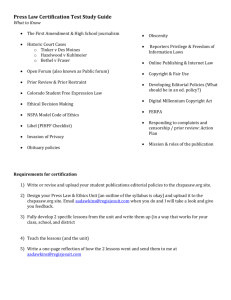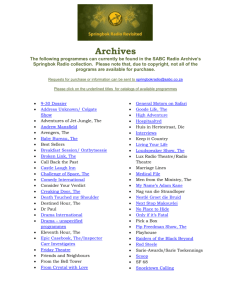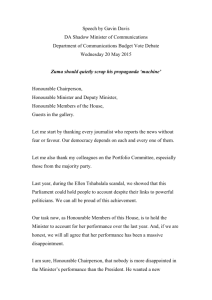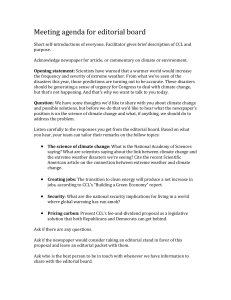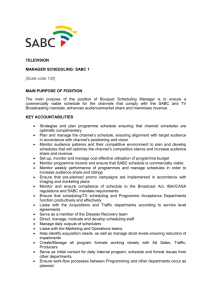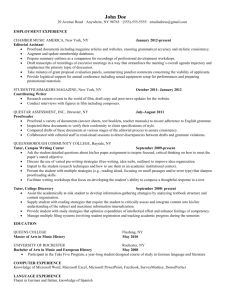View - SABC
advertisement
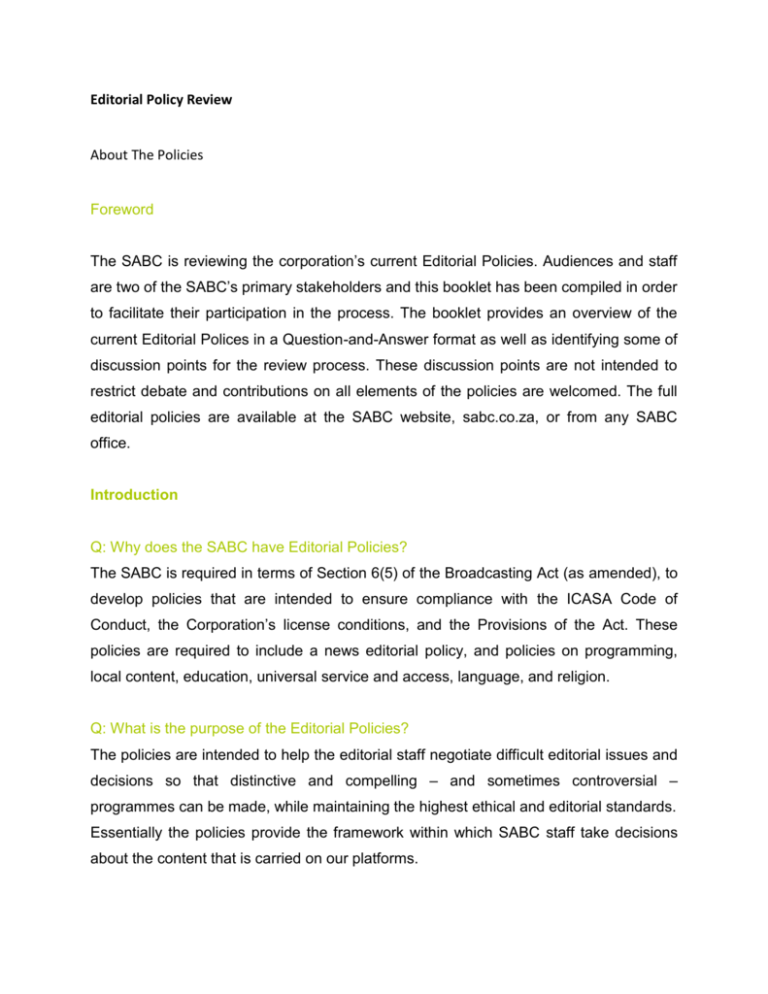
Editorial Policy Review About The Policies Foreword The SABC is reviewing the corporation’s current Editorial Policies. Audiences and staff are two of the SABC’s primary stakeholders and this booklet has been compiled in order to facilitate their participation in the process. The booklet provides an overview of the current Editorial Polices in a Question-and-Answer format as well as identifying some of discussion points for the review process. These discussion points are not intended to restrict debate and contributions on all elements of the policies are welcomed. The full editorial policies are available at the SABC website, sabc.co.za, or from any SABC office. Introduction Q: Why does the SABC have Editorial Policies? The SABC is required in terms of Section 6(5) of the Broadcasting Act (as amended), to develop policies that are intended to ensure compliance with the ICASA Code of Conduct, the Corporation’s license conditions, and the Provisions of the Act. These policies are required to include a news editorial policy, and policies on programming, local content, education, universal service and access, language, and religion. Q: What is the purpose of the Editorial Policies? The policies are intended to help the editorial staff negotiate difficult editorial issues and decisions so that distinctive and compelling – and sometimes controversial – programmes can be made, while maintaining the highest ethical and editorial standards. Essentially the policies provide the framework within which SABC staff take decisions about the content that is carried on our platforms. Q: Do the policies apply only to radio and television services? No, the policies relate to all the SABC’s content, and to services for both national and international audiences. They apply to all the services, irrespective of whether they are carried on radio or television, online, by short message service (SMS) or mobile phone, produced by an SABC department or an independent company. Q: What do Editorial Policies deal with and why? The Broadcast Act of 1999 (as amended) requires the SABC to develop the following: i. News editorial policy ii. Programming policy iii. Local Content policy iv. Educational policy v. Universal service and access policy vi. Language policy and vii. Religious policy The SABC chose to include all the above in the current Editorial Policies. Additionally, there is also a section which describes the Mandate of the Corporation, which includes the Core Editorial Values of the SABC, an Editorial Code and Editorial Upward referral. In addition, the editorial policies mandated areas to develop policies that dealt with specific issues as they arose, in this context News & Current Affairs developed the following additional policies that have been approved by Board of the SABC: • Policy guidelines on the use of commentators and analysts • Policy on the coverage of state funerals • Policy on equitable coverage during national elections Q: Why is SABC reviewing the Editorial Policies? The Editorial Policies state the policies should be reviewed at regular intervals. In addition, since the Editorial Policies were initially introduced in 2004, the broadcast environment has undergone some fundamental changes which impacts on the way in which content decisions are made – this has implications for the editorial policies and the review needs to ensure that the Editorial Policies reflect these developments, while still providing an enabling environment for staff to meet the Public Broadcast mandate. Q: How is the review being conducted? The original policies were the outcome of months of consultation; this review will follow the same process – with extensive engagements with both SABC staff and members of the public. Public hearings will be conducted in each of the provinces and our audiences will also have the opportunity to participate through programmes on radio, television and using interactive media, such as facebook and the SABC website. The SABC’s experience with the current editorial policies will also inform the review as will learnings from other public broadcasters, most of which have Editorial Policies or Guidelines in place. Review: Some general issues Implementation: During the initial phase of the review, concerns were raised regarding the on-going implementation of the Editorial Policies within the SABC. In this context, is it necessary to include specific clauses within the editorial policies to ensure that they are adhered to and properly implemented across the enterprise? Commercial funding/Public Broadcasting contradiction: Almost uniquely for a public broadcaster, the SABC derives the majority of its income from the commercial sphere – specifically traditional advertising activities. This means that the SABC is subject to many singular challenges to its ability to deliver on a public broadcasting mandate and many of these challenges impact directly on the editorial decision-making process. The Editorial Policies are relatively silent in terms of managing the contradictions that can arise as a result of serving both a commercial and public mandate – are there ways in which the policies can do this? Technological developments: The most significant audience-facing technological developments, in terms of editorial policies, are: • The rise (and continuing growth) of social media. • The imminent transition from an analogue broadcast transmission network to a digital transmission network. Blogs, micro blogs, content communities and social networks are the social media that are of most concern for the Editorial Policies and within that, there are four areas that require attention in terms of the Editorial Review: • The use of social media sites as information sources, particularly in a news environment. This is an issue that can be explored more in the News & Current Affairs Section of the Editorial Policies • The use of social media networks by SABC staff in their personal capacity. A distinction will probably have to be drawn between those staff members whose public profiles are inextricably linked to the SABC and those who are not. • The use of SABC platforms to promote third party social media sites also requires review • The management of user-generated content, such as below-the-line comments on blog-style web pages. While the impact of Digital Terrestrial Television (DTT) is yet to be felt, it will have a profound effect on television content in the future. The increased bandwidth that will allow for the broadcast of far more channels, and an assessment will need to be made on whether this quantitative shift will impact on Editorial Policies. The imminent launch of DTT is also driving policy and regulatory reviews that need to be taken into consideration when engaging with the policies. Current Policies: Mandate Q: What are the core editorial values of the SABC? Equality – The SABC provides programmes for everyone, in all the official languages, and promotes universal access to its services. Editorial Independence – The SABC is governed by the Charter of the Corporation, which enshrines the journalistic, creative and programming independence of the staff of the corporation, and the constitutionally protected freedom of expression. Nation Building – The SABC celebrates South Africa’s national identity and culture, and provides its citizens with the information they need to participate in building our democracy. Diversity – The SABC reflects South Africa’s diverse languages, cultures, provinces and people in its programmes. Human Dignity – The SABC respects the inherent dignity of all South Africans, reflects them in all their diversity, and does not use language or images that convey stereotypical or prejudiced notions of South Africa’s races, cultures and sexes. Accountability – In discharging their editorial responsibilities, SABC management and staff are accountable to the SABC Board, which is charged with ensuring that the corporation complies with the Charter. Transparency – The SABC ensures that the principles of honesty, openness and transparency govern every aspect of its relationships with the Shareholder, stakeholders, suppliers and the public. Q: Why do we need these core editorial values? The values, based on those articulated in the Constitution — including national development, unity, diversity, non-racialism, non-sexism, democracy and human dignity — represent those things that are commonly held by South Africans to be important. They bridge political, class, racial and gender divides, and although we are still at the start of our project of national development, those are what anchor us as a nation. For the public broadcaster, then, they must form the foundations of its editorial policies. Review: Editorial Values • Do these values remain relevant to public broadcasting in the context of a developmental state? • Are there any values that have been omitted, should any of the current values be removed or the content given to them altered? • In addition to the issues that have been outlined above, there is also a need for the principles to be unpacked and made practical Q: What is the Editorial Code? The Editorial Code was developed by the SABC Board in 1993 and was revised to form part of the Editorial Policies in 2003. The Code emerged from the Core Values and when revised in 2003, it took into account subsequent developments in law. In its current iteration the Editorial Code has fifteen clauses, eight dealing specifically with News and Current Affairs, six with all genres and two specifically with programming. The issues addressed in the Code are also dealt with in the relevant sections of the Editorial Policies. Q: What does ‘Upward Referral’ mean? Upward referral refers to the voluntary process by which editorial staff consults their supervisor on any editorial decisions they are uncertain about. Should any difficulty arise during programme production and/or editorial control, or the programme producer or commissioning editor be unsure of anything, they should consult their supervisor for guidance. This process of voluntary upward referral extends as far as the Group Chief Executive Officer, in his/ her capacity as editor-in-chief. The SABC views upward referral as a mutually empowering, nurturing and developmental approach for all staff involved. It is not intended to shift editorial decision-making upward; rather it is intended, when required, to underpin collective decision-making and shared editorial responsibility– especially when faced with difficult decisions – and to highlight the interdependence of the credibility of the corporation and that of its editorial staff. Upward referral is also not intended to disallow the production and broadcasting of controversial and compelling programmes; rather it is intended to make and commission such programmes while maintaining the highest ethical and editorial standards. Q: Are there any matters that must be referred upwards? There are certain matters that when dealt with by editorial staff, they must be referred upwards. These instances would include interviews with criminals or people wanted by the police, and showing or featuring people in a live broadcast for entertainment purposes using hidden cameras. There are a total of fourteen instances, listed in the Editorial Policies document, which are mandatory to be referred upwards. Review: Editorial Code & Upward Referral • Is it necessary to prescribe under what circumstances upward referral is mandatory and, if it is, is the list as set out in Editorial Policies appropriate or do items need to be added or removed from that list? • Is it appropriate for the Group Chief Executive Officer to be the Editor in-Chief’, if not who assumes ultimate responsibility for Editorial Content and how is that exercised? Current Policies: Programming Q: What policies and regulatory requirements govern the SABC programme content? • The Charter • The SABC’s Core Editorial Values • The SABC’s Editorial Code of Practice • The SABC’s obligation to comply with the industry standard, the Code of Conduct for Broadcasters, which is administered by the BCCSA • The SABC’s obligation to comply with ICASA license conditions and regulations Q: Are there any principles that guide the SABC’s programming? The SABC’s approach to programming is guided by the following principles: • The programmes are underpinned by the SABC’s core editorial values. These influence the production, commissioning and acquisition of all its programmes • The SABC endeavors to offer a wide range of information, education and entertainment in a variety of genres and formats, in which everyone should find something of interest some of the time • As the national public broadcaster it is the SABC’s duty to encourage the development of South African expression. It therefore showcases South African talent, supports South African culture, and aims to develop programmes that are identifiably South African. • The SABC aim is to contextualise for South Africans their life as global citizens, and to bring them the very best of programmes the world has to offer • Given our history, and that South Africa is part of Africa, the SABC deems it its responsibility to endeavour to represent Africa and African stories fairly and diversely • Freedom of expression is at the heart of SABC programmes. Q: Why do we have to give adequate warning to viewers about content in programmes? Careful scheduling and appropriate warning or advice allows our public to make informed choices about what they want to see and hear. This practice does not detract from the SABC’s editorial responsibilities in any way, but actually entrenches the culture of respect for freedom of expression, and the right to receive and impart information. Q: What are the various symbols we use as warnings? The Code of Conduct for Broadcasters requires us to give audience advisories that are clear to audiences so that they can make informed choices about what they would like to see or hear; or allow their children to see or hear. These include age indicators (13, 16, 18), and symbols for content – violence (V); explicit sexual conduct (S); nudity (N); bad language, including profanity (L); and prejudice (P). Q: Why are programmes dealing with adult themes broadcast late at night? The watershed period (21:00 – 05:00) is the time after which progressively more adult material may be shown on television. Before the watershed, material which is not suitable for children may not be shown. The watershed is regulated by the Code of Conduct for Broadcasters and infringements are dealt with by the BCCSA. Q: Is there a watershed time for radio? Although the Code of Conduct for Broadcasters does not specify a watershed period for radio, the SABC abides by the dictum that stations do not broadcast material that is unsuitable for children at times when they are likely to form a large part of the audience. For instance, stations should be aware that children are likely to be listening to the radio while travelling to and from school. Q: What do I do if a programme has profanity? The Code says that bad language, including profanity and other religiously insensitive material, should not be used in programmes that are specially designed for children. Further, that no excessively or grossly offensive language should be used before the watershed on television, or at times when large numbers of children may be expected to be in the audience. The SABC’s Programming policy acknowledges that although profanity has become a part of daily expression and hence is frequently used on television, it is offensive to many viewers. The SABC therefore endeavors to apply the “L” warning symbol rigorously when profanity is concerned, in order to minimize distress to those audiences who may be offended. The following BCCSA guidelines should also apply: • In the case of a drama or documentary unless particularly aggravating circumstances are present, taking in vain of the Lord’s Name may be used in post-watershed feature films by characters or persons portrayed in broadcasts, subject to due warning as to language, and with an appropriate age restriction. • In family time the words have to be removed insofar as it is possible to do so. High frequency is not allowed. • Where presenters use such language in a derogatory manner towards listeners – even after the watershed – it amounts to a contravention of the Code. Q: What does the policy say on our role in terms of language usage in programmes? A public broadcaster is an important source of information and culture, and could influence standards and values through its use of language. The SABC has therefore to maintain high standards of integrity with regard to language usage. Guidelines are as follows: • Not to use language simply for its shock value • Never to use profanity gratuitously • Not to ban the use of bad language in programmes, but to permit it only when it is defensible in terms of context and authenticity/credibility • That language usage should take religious sensitivities into account. Q: What is the SABC’s policy on discrimination in respect of disability? The SABC recognises that groups with disabilities often feel marginalized, and that it is a duty of the public broadcaster to promote access by these audience segments to its services and programmes and to ensure that the presentation of people with disabilities in our programming is fair. The SABC therefore treats people with disabilities respectfully in its programming, and we are committed to reflecting issues of disability in a way that does not perpetuate harmful negative stereotypes of the disabled. We are also committed to exploring mechanisms for enhancing our delivery to people with disabilities. Where possible, we also strive to involve disabled persons in such initiatives. Q: What is the SABC doing in terms of discouraging violence against women? The Editorial Policies of the SABC specifically state that its programming content, when judged within context, does not promote violence against women depict women as passive victims of violence and abuse degrade women and undermine their role and position in society promote sexism and gender inequality reinforce gender oppression and stereotypes. Q: When is it acceptable to broadcast scenes of violence on television? The Code of Conduct lays down very stringent requirements of when violence can be broadcast or not. To supplement this, the Programming Policy of the SABC states that scenes containing images of violence may only be broadcast if they are needed in order to portray legitimate information or context. The SABC therefore has a duty not to glamorise any type of violence, nor to promote it, and to depict it only when it could help to portray a story, evoke compassion, prompt help, or simply be an accurate representation of real events. If used at all, audience advisories are essential. The SABC’s aim is not to see how much violence will be tolerated, but how little is needed to achieve honest ends without undue dramatic or editorial compromise. Q: Does the Editorial Policy protect the right to dignity and privacy? The Code requires the electronic media to exercise exceptional care and consideration in matters involving the private lives and private concerns of individuals, bearing in mind that the right to privacy may be overridden by legitimate public interest. The SABC expects decisions of this kind to be taken with due consideration of the Corporation’s values. Q: Who decides what children see or hear? Broadcasters may not transmit material that is unsuitable for children at times when large numbers of them may be expected to be in the audience. Despite this, the onus is on parents to take decisions on what their children may or may not watch, as long as we fulfill our obligation to air appropriate advisories which allow them to make this decision. Q: I have heard that censoring a film is illegal. Is this true and how does the SABC handle it? Censorship as it existed in the old era, where only the interests of a few were taken into account, is no longer sanctioned by South Africa’s new Constitutional environment in which there are very few limitations on freedom of expression. In order to allow audiences to make their own choices, the preference is to provide warnings on air to enable them to make such choices. It remains then the right of every individual to decide what to watch and regulate what children may watch. Q: How do we deal with complaints from the public about our broadcasts? Complaints from members of the public that are received at the SABC and relate to matters of policy, or compliance with the Code, are dealt with by the office of the Manager: Broadcast Compliance. When such complaints are received by the channels or stations, or in any other department, they should be referred to that office without delay. The SABC’s policy is to deal with every such complaint. The response is either prepared in consultation with, or communicated immediately to, the management of the channel/station concerned, or the relevant head of SABC News. The services are required to take ownership of complaints about their services. Q: Does the SABC control what may be advertised on its services? Yes, to the extent that the SABC complies with the rules prescribed by the Advertising Standards Authority of South Africa. The Sales and Marketing Division also reserves the right to accept or reject advertisements which are not deemed to be in the public interest or which are contrary to the SABC’s own Editorial Policies. Q: What are the guidelines on stereotyping? We undertake to include in our programming non-stereotypical representations of the disabled, women, black and homosexual people, and of any other South Africans who have often been marginalised by the mainstream media, or represented in narrow and stereotypical terms. The SABC’s policy is as follows: 1. To treat every part of society with respect 2. Not to identify people solely by ethnic origin, and to mention colour only when it is relevant to the topic under discussion 3. To avoid any unnecessary reference to disability, as it is often seen as insulting or implying deficiency, and not to use language that could add to such an impression: e.g. “deaf” or “hard of hearing” should be used, and “a person who has a disability” instead of “invalid” or “cripple” or “retarded” 4. To use non-sexist language so as to avoid giving offence, or creating the impression – through repetition - that certain activities are associated with only one sex. Review: Programming • Are the above still relevant, are there instances where a more (or less restrictive or proscriptive approach should be adopted? • In a number of instances – such as the policies regarding violence and sex & nudity are essentially lifted from the Broadcast Complaints Commission of SA Code. Should these be included in the policy and, in those instances where it is, which takes precedence should a change be made to the code from which the clause/s comes from? • What relevance does this section have for on-line or other non-traditional services? • In this section, as well as News & Current Affairs, there is a commitment to achieving gender representivity – however, neither of these commitments defines the concept nor do they provide guidance on how it can be achieved. • Much of the programming section is about restrictions – should there be a greater focus on what should be done and how it should be done? Current Policies: News Q: Does the GCEO have control over News and programming? The role of Editor-in-Chief is one of many responsibilities that the GCEO assumes and should not be confused with the functions of the Heads of Radio, Television, News, Sport and Education or of the other Editors and Channel and Station Managers employed by the SABC. The GCEO’s role is not to make day-to-day programming or newsroom decisions. However, the Board of the SABC delegates responsibility, and holds accountable the GCEO for the performance of all news and other programmes, broadcast and presented on all SABC radio, television, internet and other services. Review: News • Are the above (& other clauses) in the policies still relevant and where should adjustments be made? • SABC has been criticized for biased reporting; are there specific elements of the policies that can be used to address this? • In the context of criticisms of how the SABC reports on itself has been dogged by controversy, how can the Editorial Policies be structured so that staff are empowered to report on itself fully and fairly? Current Policies: Language Q: What is the SABC commitment in respect of broadcasting in all official languages? The main commitments are to: • Provide a range of distinctive, creative and top quality programmes in all 11 official languages across our radio and television portfolio, and strive to reflect the needs of each language community in our programming • Maintain distinct and separate radio services in each of the 11 official languages • Treat all the official languages equitably on our television services • Integrate South Africa Sign Language into broadcasting as a means of making programming accessible to people with hearing disabilities • Strive to include other non-official languages spoken in South Africa, with particular emphasis on the Khoi, Nama and San languages. Q: What is our position on non-official languages and sign language? The SABC commits itself to providing quality radio programmes in non-official South African languages, in particular in the Khoi, Nama and San languages. The SABC progressively expands the amount of programming that is signed, beginning with selected news and current affairs, and events of national importance. Special efforts are being made to provide Sign Language interpretation when programmes are recorded in front of live audiences. Q: What does “equitable treatment “of languages mean? The term equitable means just, fair and reasonable — not necessarily equal— treatment. In this regard, the SABC aims to broadcast every official language on television, while ensuring that programmes are accessible to as many viewers as possible. We aim to complement our national television service by providing regional services as required by the Broadcasting Act, (as amended) pending the licensing of these services by ICASA and appropriation of funds for this purpose, by Parliament. Equitability is achieved through a combination of means, including unilingual productions and multilingual programmes. We strive to explore the use of technologies such as subtitling to ensure that programmes are accessible to as many viewers as possible. At times this objective is met the best by broadcasting in cognate or widely understood languages. When this is applied, the SABC rotates the use of languages in any cognate group in order to achieve equitability. Q: What is our approach on multilingual broadcasting? The SABC is conscious of the part multilingual programmes can play in promoting knowledge and understanding of the country’s diversity of languages and cultures. Such programmes, when used creatively, also reach out to wider audiences. Accordingly, the SABC actively encourages production of meaningful multilingual programmes as a means of attaining its language broadcasting objectives. Multilingual programmes are those that include substantial amounts of more than one official language. Q: Which South African languages are recognised in the policies as more marginalized than others? XiTsonga, TshiVenda, SiSwati and isiNdebele are recognised as being more marginalised than the others and there is an additional responsibility on institutions such as the SABC to address this marginalization. Q: What factors are taken into account when deciding how much time each language gets on television? In determining allocation of time to each language, the SABC has due regard to: • The number of home language speakers in the coverage area of a channel • The geographical spread of the language • The extent to which members of a language community are able to understand other languages. • The extent of marginalisation of the language • The extent to which it is understood by other South Africans • Available resources. Review: Language • Are the above (& other clauses) in the policies still relevant and where should adjustments be made? • The commitment to redressing past imbalances and with the exception of noting that resource allocation should take this into consideration, does not go beyond that; should the editorial policies include such a commitment and if they do, should it be unpacked to indicate how these past imbalances can be addressed. • What position should the SABC take with the evolution of language? Is it alright to make use of slang in programming or should the SABC be the protector of language purity? • Should the SABC take it upon itself to be a custodian of language, how does it go about measuring the purity of language? There are eleven (11) official languages in South Africa, all of which have difference variations, what measure is used to determine which dialect is pure? Current Policies: Universal Services Q: How much of South Africa’s population does the SABC cover with its three television channels? Coverage is currently as follows: SABC1 - 89% SABC2 - 91% SABC3 - 77% Review: Universal Services • Are the above (& other clauses) in the policies still relevant and where should adjustments be made? • Considering all other parts of the Editorial Policies deal specifically with content, is it appropriate for this part to be included in the Editorial Policies? Current Policies: Local Content Q: What are the three areas in which local content is prescribed by ICASA? Global local content quotas for each television channel. These stipulate that a percentage of the air time between 05:00 and 23:00 should be allocated to local content. The global quotas distinguish between public and commercial television • Genre quotas. These stipulate that if a television channel carries a certain genre of programming (such as drama), a percentage of that type of programming is to be allocated to local content. The genres are defined in the ICASA regulations3 and span the following six areas: drama, informal knowledge building, children’s, education, documentary and current affairs. In each case a minimum percentage is prescribed These quotas also distinguish between public and commercial television • Independent production quotas. Here the stipulation is that a percentage of the total amount of local content aired must be allocated to independent television productions. These quotas make no distinction between public and commercial services. All the quotas are set out in regulations which may be reviewed by ICASA every three years. Review: Local Content • Are the above (& other clauses) in the policies still relevant and where should adjustments be made? • The policies commit the SABC to developing African content; how do we deal with that? • The policies commit the SABC to developing African content; how do we deal with that? • Does the SABC have any local content responsibilities beyond the licensed services – if so should it be reflected in the Editorial Policies? • Earlier in the document, the issue of the appropriate management of the content value chain in order to deliver public mandate broadcasting was raised as an issue that needs to be addressed – this may be the appropriate place to do so. Current Policies: Religious Broadcasting Q: How is airtime for religious programming allocated? In allocating air time to religious groups, the SABC is committed to the principle of fairness and applies this principle in determining the time allocated to each group. These allocations are made on a three-yearly basis, after consultation with the Religious Broadcasting Panel (RPB), taking the following into account: • Data on the percentage of the population in each religious group, as per the latest available census information. • The need for each of the major religions to enjoy meaningful and sufficient programming of a faith specific nature • The need for all the religions to be reflected in religious programmes • The need for sufficient programming of a multifaith nature • The need to redress past imbalances in religious broadcasting. Q: Why does the religious programme policy give special attention to African Religion? Religious broadcasting should strive to be contextual and relevant, and to reflect our African reality. Towards further correction test of the neglect of African culture in the public media, special attention is given to African Religion and traditional cultures Review: Religious Broadcasting • Are the above (& other clauses) in the policies still relevant and where should adjustments be made? • The religious policies locate editorial control of meditational programmes outside the SABC. The policy also allows for the establishment of a Religious Broadcasting Panel, which will report to the Board, define the allocation of time to different religious groups and liaise with religious communities. Both these appear to be abrogation of editorial control being located within the SABC and should be addressed. • The most important issue that arose regarding Religious Broadcasting, was whether or not the assumptions made around the importance of broadcasting as per sectarian interests was appropriate. • Is the identification of the major religions still appropriate & how are the sometimes considerable differences within religions, eg Shi’ite & Sunni, Orthodox & Pentecostal managed? • Paid for broadcasts have been raised as problematic in the context of public service religious broadcasting, but the Editorial Policies allow it – is this appropriate? Current Policies: Education Q: What are the six broad areas in which the SABC provides educational programmes across its services? Arising from the Broadcasting Act, the SABC has identified the following educational programme areas: • Early Childhood Development • Children at Home • Formal Education • Youth Development • Adult and Human Resources Development • Public Education Q: What priority is given to education needs? The SABC ensures that its educational programmes address imbalances in the historical provision of education, especially, but not exclusively, those based on race, gender and disability The SABC links its educational broadcasting to national priorities and needs, supporting the achievement of outcomes based education, lifelong learning, and the association of educational and life experiences. Q: Does the SABC’s educational programming policy commit to formal or informal education or both? The SABC commits itself to providing innovative educational programmes of excellent quality across our radio and television services, aimed at meeting the diverse formal and informal learning needs of all our audiences, including children, youth and adults. Review: Educational Programming • Are the above (& other clauses) in the policies still relevant and where should adjustments be made? • Education is the only part of the Policies that deals extensively with children’s programming. However, the Reithian formulation of entertaining and informing applies to youngsters as well – surely the provision needs to be made for policies around children’s programming. Where can I get a copy of the current Editorial Policies? To get a copy of the current Editorial Policies, please www.sabc.co.za/editorialpolicy How can I get more information on the Editorial Policies review? To get more information email editorial@sabc.co.za or call (011) 714 9111 Where can I send my submission into the Editorial Policies? You can send your submission through the following channels: Email: editorial@sabc.co.za Post: Editorial Policies Private Bag X1 Auckland Park 2006 go to


